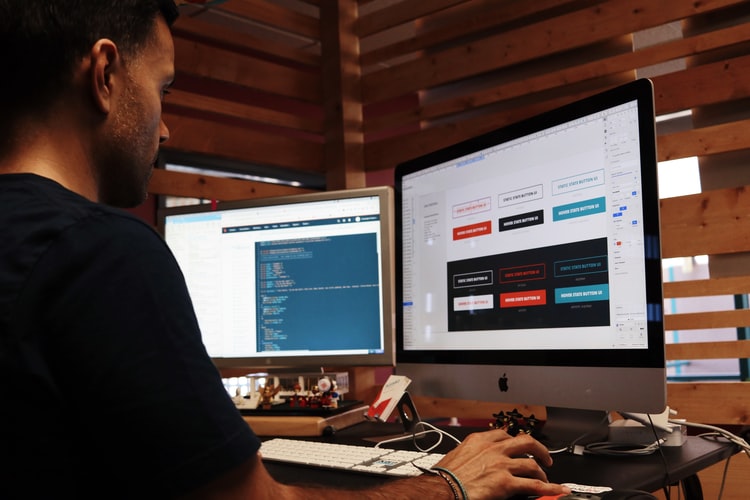How to use AI to help with web design experimentation
Introduce innovative design ideas with the power of AI

AI is rapidly transforming the field of web design, opening up new possibilities for experimentation and innovation. By leveraging AI tools, such as the best AI website builders, you can quickly generate and test a wide range of ideas, from color schemes and layouts to personalized user experience flows.
Experimenting with different design variations is crucial for creating websites that stand out and effectively engage target audiences. Here’s a step-by-step guide to help you get started with AI-driven web design experimentation, complete with tips, strategies, and tooling suggestions.
1. Analyze website data to identify problem areas
To effectively use AI in your web design experimentation process, start by analyzing your website data to pinpoint areas that need improvement. AI-powered analytics tools can provide valuable insights into user behavior, helping you identify underperforming pages, high bounce rates, confusing navigation paths, or low conversion points.
Focus your experimentation efforts on the pages that have the biggest impact on your website's success. Typically, this includes your homepage, key landing pages, product pages, and critical conversion points like signup forms or checkout pages.
When analyzing your website data, look for patterns and anomalies that indicate potential problems. For example:
- Pages with high bounce rates or low average time on page
- Confusing or inefficient user flows leading to key conversions
- Underperforming call-to-action buttons or form fields causing drop-offs
- Slow loading times or technical errors impacting user experience
Some powerful AI-enhanced analytics tools to consider include Google Analytics, Hotjar, and Optimizely. These tools can help you understand user behavior, visualize interactions through heatmaps and recordings, as well as personalize user experiences based on behavioral data.
2. Generate design ideas and inspiration with AI
Once you've identified the key areas for improvement on your website, it's time to start generating fresh design ideas and inspiration. This is where AI can really shine, helping you quickly create and explore a wide range of design variations.
AI-powered design tools can assist with various aspects of the ideation process, from color palettes and typography to layouts and visual elements. By using these tools, you can experiment with different design styles, trends, and combinations in a fraction of the time it would take to do so manually:
Sign up to the TechRadar Pro newsletter to get all the top news, opinion, features and guidance your business needs to succeed!
- Adobe Sensei: Integrated into Adobe Creative Cloud, Sensei uses AI and machine learning to help you automate tasks, generate design variations, and make intelligent recommendations based on your project.
- Khroma: An AI-powered tool that generates unique color palettes based on your preferences and design goals. It can help you explore different color schemes and find the perfect combination for your website.
- Uizard: An AI-assisted design tool that helps you quickly create wireframes, mockups, and prototypes. It offers a range of templates and design elements that you can customize and combine to suit your needs.
- AutoDraw: A web-based tool that uses AI to recognize your sketches and suggest relevant icons, illustrations, and design elements. It's a great way to quickly generate visual ideas and inspiration for your website.
When using these AI tools for design ideation, don't be afraid to experiment and push the boundaries. Create multiple variations of each design element, mixing and matching different styles, colors, and layouts. Share these variations with your team and gather feedback to refine your ideas further.
Remember, the goal at this stage is not to create a perfect final design, but rather to explore a wide range of possibilities and find the direction that resonates best with your target audience. That way, you can unlock new creative avenues and set the stage for more targeted experimentation in the later stages of the design process.
3. Create website structure and layouts
With a clear direction for your website's design, it's time to start creating the structure and layout of your pages. AI can help streamline the process by generating optimized website structures and content outlines based on your goals and target keywords.
For example, ChatGPT can create an outline for your homepage, including key sections like the hero area, featured products, customer testimonials, and a clear call-to-action. With Visily, you can quickly generate and iterate on different page structures, experimenting with the placement of various design elements like navigation menus, images, and content blocks.
But remember that blindly using AI-generated layouts in your designs can end up hurting the user experience. When using AI to generate website structures and layouts, keep the following tips in mind:
- Provide clear input and guidelines to the AI, including your website's purpose, target audience, and desired action you want users to take.
- Use the AI-generated structures and layouts as a starting point, but always review and refine them based on your own expertise and understanding of your users' needs.
- Ensure that the generated structures follow best practices for web design, such as clear navigation, responsive layouts, and accessibility considerations.
- Iterate and experiment with different variations of the AI-generated structures, testing them with users to gather feedback and identify areas for improvement.
4. A/B test your ideas for maximum impact
A/B testing is a crucial step in validating your web design experiments and ensuring they have the desired impact on user behavior and conversions. By comparing two or more variations of a design element, you can determine which one performs better and optimize your website accordingly.
AI-powered A/B testing tools can streamline this process by automatically allocating traffic to different variations, analyzing the results, and identifying the winning designs. This saves you time and effort while providing data-driven insights to guide your optimization efforts. Some popular AI-driven A/B testing tools include:
- AB Tasty: A powerful A/B testing tool that integrates with Google Analytics, allowing you to easily set up and run A/B tests across your website.
- Optimizely: A comprehensive experimentation platform that leverages AI to help you create, run, and analyze A/B tests at scale. It offers advanced targeting and segmentation capabilities, as well as automated insights and recommendations.
- VWO (Visual Website Optimizer): An all-in-one platform for A/B testing, heatmaps, and user surveys. It uses AI-powered insights to help you understand user behavior and make data-driven design decisions.
When conducting AI-driven A/B tests, start with a clear hypothesis and goal for each test and ensure that your test variations are distinct enough to provide meaningful results. Run tests for a sufficient period to gather statistically significant data, typically at least one to two weeks, depending on your website traffic.
5. Prevent plateauing with AI-powered analytics
Even after you've optimized your website through AI-driven experimentation, it's essential to keep monitoring its performance and making data-driven adjustments to prevent stagnation. AI-powered analytics tools can help you stay on top of user behavior trends, identify new opportunities for improvement, and ensure that your website continues to evolve and grow.
Some ways to use AI-powered analytics to prevent plateauing:
- Set up automated alerts for significant changes in user behavior or performance metrics, so you can promptly identify and address any negative trends.
- Use predictive analytics to forecast future user behavior and proactively optimize your website for anticipated changes in traffic, demographics, or market trends.
- Leverage AI-driven segmentation to identify specific user groups or behaviors that may require targeted optimization efforts, such as high-value customers or users who are likely to churn.
- Continuously monitor and analyze user feedback and sentiment using AI-powered tools like chatbots, surveys, and social media listening, to identify areas for improvement and new opportunities for experimentation.
To get the most out of AI-powered analytics, it's important to have a clear strategy and framework for continuous improvement. This should include regular review sessions where you analyze the data, identify key insights and opportunities, and prioritize actions based on their potential impact and feasibility.
Remember to focus on metrics that directly tie to your business goals, encourage a culture of data-driven experimentation, and perform regular check-ins with stakeholders to keep them in the loop. But avoid relying on AI-powered analytics as the only source, combine it with qualitative insights from research, surveys, and customer interviews.

Ritoban Mukherjee is a tech and innovations journalist from West Bengal, India. These days, most of his work revolves around B2B software, such as AI website builders, VoIP platforms, and CRMs, among other things. He has also been published on Tom's Guide, Creative Bloq, IT Pro, Gizmodo, Quartz, and Mental Floss.
- Owain WilliamsB2B Editor, Website Builders & CRM